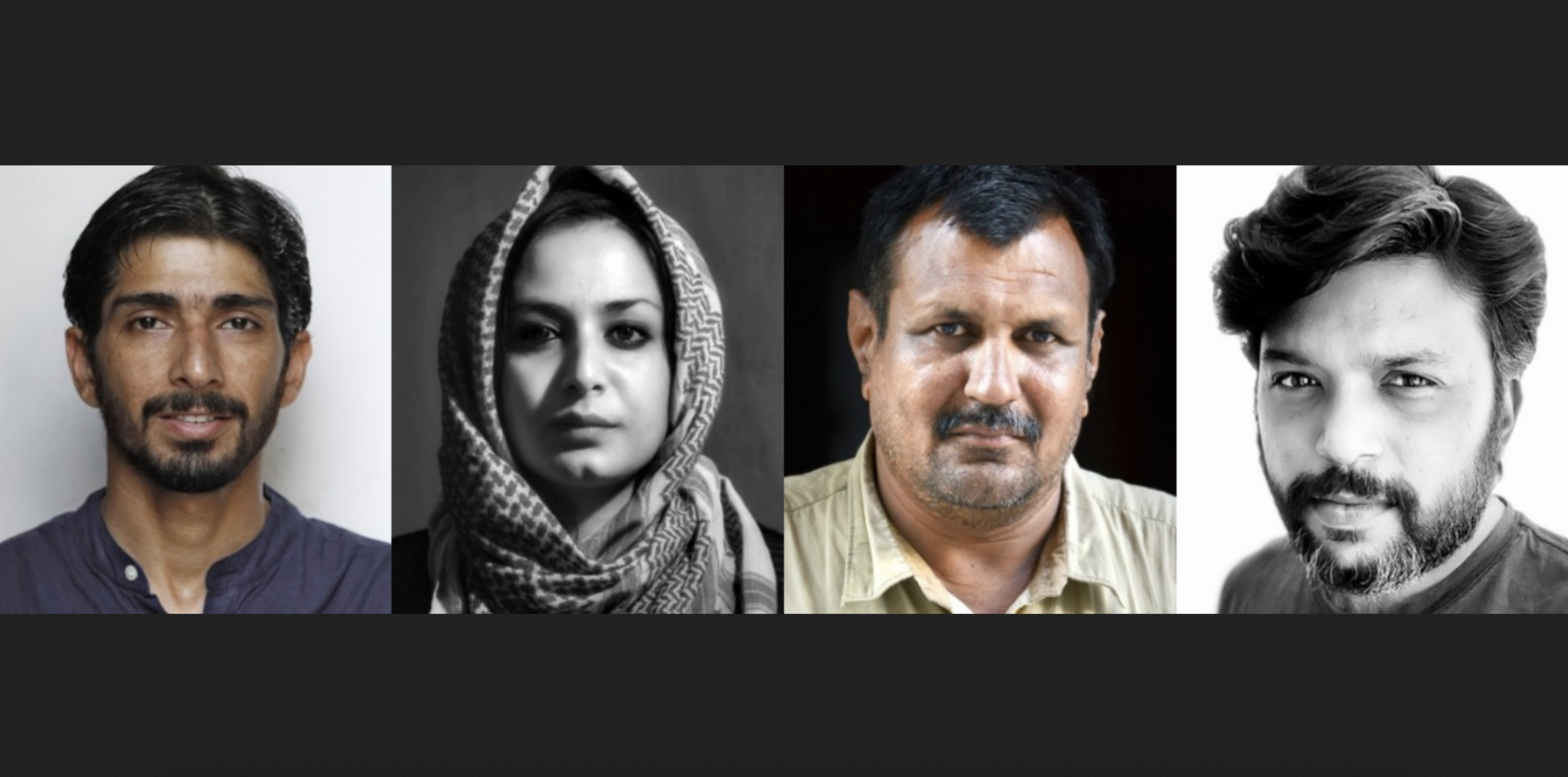भारतातील कोविड-१९ महासाथीचे वृत्तांकन करणाऱ्या रॉयटर्सच्या ४ छायाचित्रकार-पत्रकारांची २०२२चा छायाचित्रणातील प्रतिष्ठेच्या पुलित्झर पुरस्कारासाठी निवड
भारतातील कोविड-१९ महासाथीचे वृत्तांकन करणाऱ्या रॉयटर्सच्या ४ छायाचित्रकार-पत्रकारांची २०२२चा छायाचित्रणातील प्रतिष्ठेच्या पुलित्झर पुरस्कारासाठी निवड झाली आहे. या पत्रकारांची नावे अदनान अबिदी, सन्ना मट्टू, अमित दवे व दानिश सिद्धीकी (मरणोत्तर) अशी असून या चौघांनी भारतातील कोविड महासाथीचे दाहक वास्तव छायाचित्रांतून जगापुढे आणले होते.

FILE PHOTO: A bank employee maintains order as customers wait in lines to enter a bank during a 21-day nationwide lockdown to slow the spreading of coronavirus disease (COVID-19) in Agra, India, April 7, 2020. REUTERS/Danish Siddiqui/File photo

A woman wearing a face mask travels inside a Delhi metro train, on the first day of the restart of their operations, amidst the spread of coronavirus disease (COVID-19), in New Delhi, India, September 7, 2020. REUTERS/Adnan Abidi

A vendor wearing a protective face mask reads a newspaper at his stall as he sells face masks and newspapers amidst the coronavirus disease (COVID-19) outbreak in Srinagar, September 7, 2020. REUTERS/Sanna Irshad Mattoo

FILE PHOTO: Patients suffering from the coronavirus disease (COVID-19) get treatment at the casualty ward in Lok Nayak Jai Prakash (LNJP) hospital, amidst the spread of the disease in New Delhi, India April 15, 2021. REUTERS/Danish Siddiqui

A patient is wheeled inside a COVID-19 hospital for treatment, amidst the spread of the coronavirus disease (COVID-19) in Ahmedabad, India, April 19, 2021. REUTERS/Amit Dave

Healthcare workers wearing personal protective equipment (PPE) collect swab samples from men during a rapid antigen testing campaign for the coronavirus disease (COVID-19), at an auditorium turned into a testing centre in Ahmedabad, India, March 23, 2021. REUTERS/Amit Dave

Migrant workers and their families, who had left during a lockdown, walk at a platform after they returned from their home state of Uttar Pradesh, after authorities eased lockdown restrictions that were imposed to slow the spread of the coronavirus disease (COVID-19), in Ahmedabad, India July 1, 2020. REUTERS/Amit Dave

A healthcare worker wearing personal protective equipment (PPE) takes a swab from a migrant laborer for a rapid antigen test at the site of an under construction residential complex amidst a coronavirus disease (COVID-19) outbreak in New Delhi, India, September 19, 2020. REUTERS/Adnan Abidi

Dr. Kumar Gaurav, 42, a medical professor and consultant psychiatrist who has been named the top official at Jawahar Lal Nehru Medical College and Hospital during the coronavirus disease (COVID-19) outbreak, despite being one of its most junior consultants, wears personal protective equipment (PPE) as he speaks to a nurse who contracted COVID-19, on the Intensive Care Unit (ICU) of Jawahar Lal Nehru Medical College and Hospital in Bhagalpur, Bihar, India, July 26, 2020. “We don’t know who is positive and who is negative,” says Gaurav. “We don’t know their status and we cannot wait for them to be tested. They just need the treatment. We are the most vulnerable population.” REUTERS/Danish Siddiqui

Health worker speaks to the relative of a COVID-19 victim, before the cremation in New Delhi, India, November 13, 2020. REUTERS/Danish Siddiqui

A healthcare worker wearing protective gear squeezes the sweat out of his face masks as he takes a break from taking swab from the residents for rapid antigen test, amidst the coronavirus disease (COVID-19) outbreak, at a residential area in Ahmedabad, India, July 24, 2020. REUTERS/Amit Dave

Children of migrant workers wearing protective face masks wait to cross the border to their home state of Uttar Pradesh, during an extended nationwide lockdown to slow the spread of the coronavirus disease (COVID-19), in New Delhi, India, May 16, 2020. REUTERS/Adnan Abidi TPX IMAGES OF THE DAY – RC2SPG9E5LTE

A barber wearing a protective face mask looks at his mobile phone as he waits for customers, amidst the spread of coronavirus disease (COVID-19), in the old quarters of Delhi, India, August 24, 2020. REUTERS/Adnan Abidi

A mass cremation of victims who died due to the coronavirus disease (COVID-19), is seen at a crematorium ground in New Delhi, India, April 22, 2021. Picture taken with a drone. REUTERS/Danish Siddiqui

People carry oxygen cylinders after refilling them in a factory, amidst the spread of the coronavirus disease (COVID-19) in Ahmedabad, India, April 25, 2021. REUTERS/Amit Dave
या यादीतील भारतीय पत्रकार दानिश सिद्दीकी हा गेल्या वर्षी अफगाणिस्तानातील यादवीचे वृत्तांकन करताना ठार झाला होता. युद्धाचे छायांकन हा दानिशचा मुख्य विषय होता. त्याची २०१८ साली रोहिंग्या यादवीचे वृत्तांकन केल्या प्रकरणी पुलित्झर पुरस्कारासाठी निवड झाली होती. त्यानंतर २०२२ सालचा त्याला मरणोत्तर पुलित्झर पुरस्कार घोषित झाला आहे.
गेली दोन वर्षे भारतात कोविड-१९ महासाथीने हाहाकार माजवला होता. २०२१ मध्ये कोविडच्या दुसऱ्या लाटेत हजारो कोविड रुग्ण ऑक्सिजनच्या कमतरतेपायी मरण पावले होते, तर हजारो रुग्णांना वेळेवर वैद्यकीय उपचार न मिळाल्याने त्यांचे प्राण गेले. रॉयटर्सच्या या चार छायाचित्रकारांनी या दुसऱ्या लाटेचे वास्तववादी छायाचित्रण करत भारतातील कोविड परिस्थिती, सरकारची अनास्था व हतबल झालेला समाज आणि वैद्यकीय सेवा यांच्यावर प्रकाशझोत टाकला होता.
भारतात कोविड-१९चे सुमारे ४० लाखाहून अधिक मृत्यू झाल्याचे जागतिक आरोग्य संघटनेचे मत आहे पण केंद्रातील मोदी सरकारने ही आकडेवारी फेटाळून लावली आहे. काही दिवसांपूर्वीच जागतिक आरोग्य संघटना व मोदी सरकार यांच्यामध्ये मृतांच्या आकड्यावरून वाद निर्माण झाला होता.
मूळ बातमी

COMMENTS